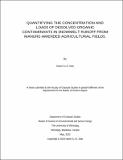| dc.contributor.author | Soto, Haven S. J. S. | |
| dc.date.accessioned | 2023-06-16T20:17:03Z | |
| dc.date.available | 2023-06-16T20:17:03Z | |
| dc.date.issued | 2023-04-15 | |
| dc.identifier.citation | Soto, Haven S.J.S. Quantifying the Concentration and Loads of Dissolved Organic Contaminants in Snowmelt Runoff from Manure-Amended Agricultural Fields; A thesis submitted to the Faculty of Graduate Studies in partial fulfilment of the requirements for the ... Master of Science in Environmental and Social Change. Winnipeg, Manitoba, Canada: The University of Winnipeg, May 2023. DOI: 10.36939/ir.202306161514. | en_US |
| dc.identifier.uri | https://hdl.handle.net/10680/2075 | |
| dc.description.abstract | Agriculture is an integral part of Canada’s economy, making 1.6% of the country’s GDP. In Manitoba, swine production contributed nearly 1.4 billion dollars in revenue from 8.4 million pigs sold to the market. Liquid swine manure is widely used as fertilizer in the province. However, there are risks with the use of liquid swine manure as fertilizer because liquid swine manure can contain organic contaminants, such as antibiotics and steroidal hormones. Globally, there is evidence of increased soil and freshwater contamination from antibiotics and estrogens, resulting in the increased presence of antibiotic-resistant genes and estrogen-related physiological disruptions, respectively. In the Canadian Prairies, a majority of the annual runoff occurs during the brief snowmelt period, when runoff occurs over frozen soils. Temporal changes in the transport of antibiotics and estrogens during this important hydrological period are not well understood but are critical to understanding the fate of these organic contaminants.
This thesis quantified the dissolved concentration and load of a 1) steroidal hormone, 17β-estradiol, and 2) antibiotic, sulfamethoxazole, in snowmelt from an agricultural field with a history of manure application under different manure management practices (i.e., no manure applied, manure applied on the sub-surface, and manure applied on the surface) over the snowmelt period. Research experiments in chapter 2 used two components (a field study during snowmelt and a laboratory simulation with flooded intact soil cores collected from the manured field) to quantify the dissolved 17β-estradiol in flood water and pore water for the laboratory simulation and snowmelt for the field study. Chapter 3 quantified the dissolved sulfamethoxazole in snowmelt in the same field study as chapter 2.
17β-estradiol (mean laboratory pore water concentration = 1.65 ± 1.2 μg/L; mean laboratory flood water concentration = 0.488 ± 0.58 μg/L; and mean field snowmelt concentration = 0.0619 ± 0.048 μg/L) and sulfamethoxazole (0.0345 ± 0.066 µg/L) were detected in all water samples, although there were no significant differences in the concentrations measured among the different manure application methods. 17β-estradiol concentrations varied between the laboratory and the field, with higher concentrations measured in the laboratory simulation. Pore water concentrations of 17β-estradiol from the laboratory study significantly increased over time, corresponding with changes in pH. In contrast, there was no significant change in the field snowmelt concentrations measured over time for both 17β-estradiol and sulfamethoxazole. The mean cumulative load of 17β-estradiol (6.91 ± 3.7 ng/m2) and sulfamethoxazole (4.12 ± 3.6 ng/m2) approximates the magnitude of 17β-estradiol and sulfamethoxazole that could be mobilized from manured fields during snowmelt. There was a significant increase in cumulative load over time for both 17β-estradiol and sulfamethoxazole, suggesting that the load is driven by the snowmelt volume rather than concentration. Furthermore, the 17β-estradiol load from plots with manure applied on the sub-surface was significantly larger than the surface application of manure and no manure application. This thesis provides preliminary insights to improve current manure management practices in the Canadian Prairies to include organic contaminants. | en_US |
| dc.description.sponsorship | "An NSERC Discovery Grant provided financial support for this research to Inoka Amarakoon and Nora Casson. I received personal financial support from the University of Winnipeg Graduate Student Scholarship." | en_US |
| dc.language.iso | en | en_US |
| dc.publisher | University of Winnipeg | en_US |
| dc.rights | info:eu-repo/semantics/openAccess | en_US |
| dc.subject | Snowmelt | en_US |
| dc.subject | Liquid swine manure | en_US |
| dc.subject | Sulfamethoxazole | en_US |
| dc.subject | 17ß-estradiol | en_US |
| dc.title | Quantifying the Concentration and Loads of Dissolved Organic Contaminants in Snowmelt Runoff from Manure-Amended Agricultural Fields | en_US |
| dc.type | Thesis | en_US |
| dc.description.degree | Master of Science in Environmental and Social Change | en_US |
| dc.publisher.grantor | University of Winnipeg | en_US |
| dc.identifier.doi | 10.36939/ir.202306161514 | en_US |
| thesis.degree.discipline | Environmental Studies and Sciences | |
| thesis.degree.discipline | Geography | |
| thesis.degree.level | masters | |
| thesis.degree.name | Master of Science in Environmental and Social Change | |
| thesis.degree.grantor | University of Winnipeg | |

